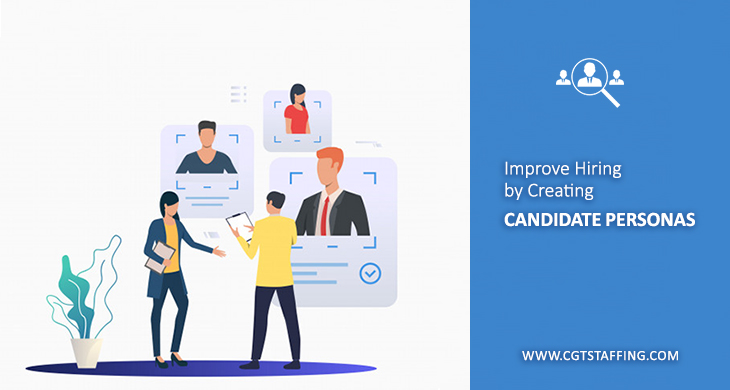Recruiters across the country are always on the lookout for suitable candidates to add to their talent pipeline. This pipeline ensures that there is a minimal disruption (and a smooth transition) when a new employee replaces an outgoing employee. With this in mind, it’s critical that recruiters make every effort to populate their pipelines with candidates that offer long-term value to an organization.
In doing so, recruiters must determine the qualities and attribute that the ideal candidate must possess in order to be properly integrated into the culture of their organization. This pursuit leads to the development of a candidate persona, which is what this blog will examine.
Table of Contents
Contents:
Let’s dive in
What Is a Candidate Persona?
In the simplest terms, it is a representation of the qualities, skills, and experience that your organization would ideally require in order to properly fill a particular role. idea theoretical grasp of the ideal candidate enables hiring managers to establish a baseline of expectation for the candidates they vet for the role. After all, when you know what you are looking for, you can better identify and segment qualified candidates from unqualified ones.
Nearly every candidate looks good on paper, but if they don’t match your defined persona, you can quickly transition the search to identify someone better suited to your needs.
You May Like: How to Hire Top Talent on a Tight Budget
The candidate persona itself is semi-fictional, and most teams already have some form of it in mind, even if they don’t use the exact term for it. Remember, after all, that it is a guiding template – it is comprised of the traits, skills, and characteristics that you would want in the perfect hire. This lends direction to the hiring process and highlights candidates that best fit the employee persona.
Why You Need It
An employee persona stems from the research-driven marketing approach to create audience personas. These personas allow marketers to better understand their audience and in so doing, to create better value propositions and identify the pain points that their products or services might better address. The purpose is to reach customers in a more effective, impactful way. In the same vein, the ideal candidate persona helps recruiters reach better candidates more efficiently, principally by:
- Increasing application volume by crafting more relevant job descriptions.
- Finding the best channels to reach target candidates.
- Acquiring better talent by aligning company-wide recruiting strategies.
How to Create a Candidate Persona?
Creating a persona has three basic tenets, whether for marketing or recruiting. These three steps help you create a research-driven, semi-fictional persona reflective of your ideal customer or candidate. A job-seeker persona is based on:
Research
The first step involves extensive research. The persona you create needs to be based on factual data, not assumptions or feelings. This research should revolve around employees, candidates, and any other stakeholders in the recruiting process.
Surveying your current workforce is a great way to source data. Ideally, those who already work at your company possess the traits and characteristics that would make for ideal new hires. That said, most recruiters know that framing the surveys correctly is essential to gathering the data you need.
They make use of a range of questions that help to crystallize variables like motivations, goals, and interests. These questions should also validate skill sets and cultural characteristics. Taken as a whole, these factors help to determine if a candidate is suitable for distinct environments like a startup culture, for example.
Keeping all stakeholders properly informed when initiating a change in the hiring strategy or process is critical. Above all, transparent communication prevents potential roadblocks later on in the hiring process. Mortgage staffing agencies, for example, schedule extensive meetings with hiring managers, recruiters, and supervisors to clearly define what they want from a new hire.
This helps staffing agencies to source candidates that fall within these definitions. These discussions cover in detail critical aspects like job descriptions, preferences for experience at previous employers, requisite job experience, and any other specific requirements for the position.
You May Like: Things to Know When Building Your Employee Handbook
By considering all of these elements, your persona should begin to take shape. The initial stakeholders whose input you solicit will provide a concrete basis for your applicant search. For more a more complete picture of your persona, however, you will ultimately have to speak to the candidates themselves. Asking candidates what attracts them to your employer brand can offer valuable insights in refining your persona.
Identifying Trends
The research phase of developing a persona is crucial to source the data you need. This data is what will allow recruiters to pinpoint a representation of the ideal hire. In its raw form, research data rarely offers a clear picture or roadmap. Analysis of sourced data is critical, enabling you and your team to identify trends. Identifying trends can be especially useful in the development of multiple personas, and can help determine commonalities between different roles.
When developing personas, you shouldn’t stop at just one, unless you are hiring individually or in bulk for specific roles as in the case of this temp agency in Pittsburgh. In fact, for multiple job roles, it is often a good idea to have as many representations as possible.
Develop Persona Stories
The final step in this process is the culmination of all your data sourcing and analysis efforts. The final refinement of persona stories provides a 360-degree view of your representation. This semi-fictional hire narrative should cover the background, interests, skills, goals, objections, previous roles and experience, and even cultural characteristics of your ideal hire. The candidate persona and stories that emerge from this process ultimately help recruiters to source better candidates and offer up better hires.
